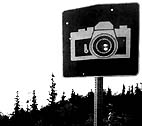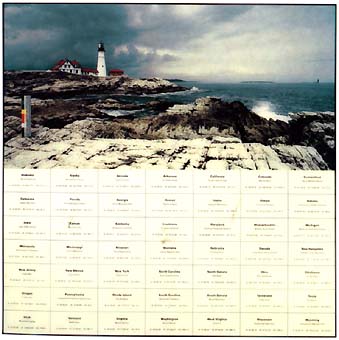| Michael Schuster K.C.C.P in USA Scenic views |
 |
| Michael Schuster K.C.C.P in USA Scenic views |
 |
The art of scene is an important element in the art of Michael Schuster. From his first collaboration with the sculptor Hartmut Skerbisch Szene aus dem gleichnamigen Stuck (Scene from the piece with the same name) to his travels to the top scenic views of the 50 states of USA. In the Neue Galerie in Graz he showed a panoramic view of these highlights of official tourism, of cultural selfdefinition, in an extravagant scene: the baroque staircase of the Neue Galerie, itself a top scenic view in Graz.
 K.C.C.P in USA, 1993 Photo / Diasec behind plexiglas.147 x 147 cm Phot. published and printed by Edition Artelier Graz 1993
This shows that Schuster's art of scene has also a tendency to selfreference. Selfreferential scenes occupy a major place in his oeuvre: from the selfphotographing space with four cameras to the automatic focusing photographic installation. Schuster has realized that this is the effect of media: turning the real into scenes, where the real becomes a wall built of fictions. His scenic views of 50 north American nations tell us how reality is constructed and staged. They show us an America without urban life, without poverty, without people, without social struggle. America looks like a paradise of recreation, like a country of nature, not a place of history. But these images are selected from Americans themselves, therefore they depict how America sees itself. The formal selfreference at the earlier work has become a tool of ideological critique: selfreferential exposure of ideology. The scenic views are distorted visions of American life, but in these pictures inbuilt is a correcting ruler, the Kodak Color Control Patches (K.C.C.P.). The ruler shows we have a photograph in front of us - guard yourself, you see a work of fiction, of ideology, of staged scenes. Schuster's scenic views are views on ideological scenes marked as natural. They are not views of the real but views on the reality of american consciousness. Media cover the world, merge with the world until the interface between observing apparatus and the observed becomes dissipative, that is not localy differentiable with precision.Through the effect of the media there is now a weak border between the territories of reality and ideology. Photography is the prime postmodern condition. Schuster's conceptual operations navigate brilliantly and logically through the twisted scenes of postmodern mediascape and real life.
Peter Weibel |